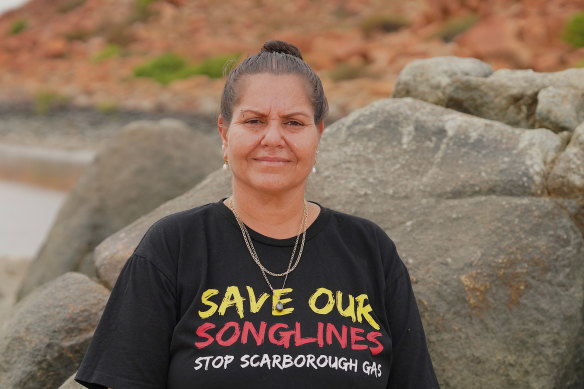
“If the Commonwealth government is serious about protecting our cultural heritage, then they must halt industry expansions on Murujuga to prevent further damage before the heritage values of the area can be independently assessed,” she said.
Loading
The WA government and Murujuga Aboriginal Corporation are leading a scientific effort to better understand if industrial emissions are damaging the engravings.
At the base of the peninsula are two vast Woodside gas export plants, Rio Tinto’s iron ore export port at Dampier and two petrochemical plants owned by Norway’s Yara.
For University of WA professor of rock art Benjamin Smith, Murujuga is the most important rock art site in the world due to the number of images – more than one million – and the 40,000 years of continuous production they represent, up to the 1800s when images of European ships were made.
Smith is concerned that pollution from the adjacent industry will damage the thin coloured layer on the rocks of Murujuga that is engraved with the rock art images.
If the layer called a patina, as thin as one-thousandth of a millimetre, dissolves or fades the art disappears.
His concern is that nitrous and sulphur oxides in the form of dust and acid rain is settling on the rocks and destroying the patina.
Smith said to date governments had favoured promotion of industry over preservation of heritage.
“World heritage nomination is highly significant, it means that a country is committing to manage a site and look after the universal values of that site in perpetuity,” he said.
“You need a much tougher regulatory system that requires the cutting of emissions by Woodside, Yara and other emitters up on the Burrup.”
The clash between the modern industry and ancient art at Murujuga was featured in a confidential briefing to WA Premier Mark McGowan before a visit to the Pilbara in 2018.

Raelene Cooper, a Mardudhunera woman, wants an end to industrial development near the Murujuga rock art.Credit:Woop Woop Pictures
The note by the WA Department of Jobs, Tourism, Science and Innovation said while World Heritage listing may boost tourism it could also deter further industrial development “without careful management.”
McGowan was told the WA government had spent $183 million on infrastructure to attract new gas processing plants to 300 hectares of land at its Burrup industrial area.
“There may be a reluctance for new industry to locate on the Burrup Peninsula should World Heritage listing go ahead before companies have obtained key approvals,” the note said.
“The timing of World Heritage listing, and associated deliberations, will be critical.”
Four months after McGowan’s trip, his government announced it would commence the world heritage nomination process.
Since then, Woodside has started doubling the size of its Pluto liquefied natural gas under existing approvals and in 2022 the WA Environmental Protection Authority recommended it can extend the operation of the North West Shelf LNG plant to 2070. The recommendation attracted more than 700 appeals that are still under consideration.
Perdaman, a private Perth-based firm, received state government approval 12 months ago to build a $US4.2 billion ($5.9 billion) urea plant using gas from Woodside but progress has been stalled by a search for financing and the collapse of engineering contractor Clough, which was to help build the plant.
Italian firm Webuild announced on Friday it would take over Clough’s role in the project.
In 2022 Norwegian fertiliser giant Yara was cleared to add a solar farm and a small green hydrogen facility to its existing gas-based ammonia plant.
The Morning Edition newsletter is our guide to the day’s most important and interesting stories, analysis and insights. Sign up here.









 Add Category
Add Category